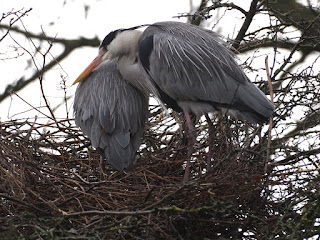The higher one is hard to see through the twigs.
The grey drizzly day was brightened by Mandarins at Peter Pan ...
... and the solitary Red-Crested Pochard.
There are Mallard drakes on the lake in every shade from black to white. Here are the pair of dark brothers, and the pale one with a brown head next to a normal coloured drake.
David Element sent an interesting picture of a Pochard--Tufted Duck hybrid at the Wetland Centre at Barnes. You can see the vermiculated pattern on his back, which is characteristic of a Pochard but absent in a Tufted Duck.
We have had several of these hybrids in the park, three in recent years, but they have all been female. Here is one.
The Great Crested Grebes on the Long Water were displaying under the willow tree, right next to a Coot's nest which they clearly envied.
Grebes can eaily drive Coots off their nests, but the Coots always win in the end by dogged persistence.
A Pied Wagtail was hunting under a cast iron bench beside the Serpentine.
The familiar Robin in the Rose Garden hopped out on the path to be fed.
There were several flocks of Long-Tailed Tits, or maybe the same flock passed several times.
The Redwings on the Parade Ground were in the trees, twittering loudly.
As I went home the rain had stopped and a Song Thrush was singing occasionally near the leaf yard.












I love the song of Song Thushes. No member of the Turdidae sings poorly, but they take the prize even among their melodious family.
ReplyDeleteI've often had the same impression that it was the same roving band of Long-tailed Tits passing me round and round time and time again. Who knows. I wonder what they think.
I can't help posting this image of an Andean Condor being released to the wild. Some say the bird is stretching it wings, some say that it is checking the air currents, and some even compare its motions to a pilot's pre-flight checklist. I can only say, watching it stretch its enormous wings and jump into the void, it's seldom that I feel so keenly how sorry our earthbound state is.
Lovely video. The condor has to feel the air under its wings before it will fly. If you find a downed Swift, unable to take off from flat ground, you must give it the same sensation by putting it on the palm of your hand and running as hard as you can so it can feel the wind. Then it will fly off.
Delete